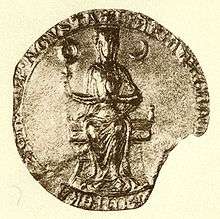Maria of Brabant, Holy Roman Empress
| Maria of Brabant | |
|---|---|
 Seal of Marie of Brabant. | |
| Holy Roman Empress | |
| Tenure | 19 May 1214 – 5 July 1215 |
| Predecessor | Beatrice of Swabia |
| Successor | Constance of Aragon |
| German Queen | |
| Tenure | 19 May 1214 – 5 July 1215 |
| Born | c. 1190 |
| Died | May/June 1260 (aged 69–70) |
| Burial | St. Peter's Church, Leuven |
| Spouse | Otto IV, Holy Roman Emperor |
| House | Reginar |
| Father | Henry I, Duke of Brabant |
| Mother | Maud of Boulogne |
Maria of Brabant (c. 1190 – May/June 1260), a member of the House of Reginar, was Holy Roman Empress and German Queen from 1214 until 1215 as the second and last wife of the Welf emperor Otto IV.
Family
Maria was the eldest daughter of Duke Henry I of Brabant and his consort Maud of Boulogne. Her paternal grandparents were Count Godfrey III of Louvain and Margaret of Limburg; her maternal grandparents were Count Matthew of Boulogne and Marie of Blois. As a descendant of the Reginar dukes of Lower Lorraine, her father Henry had adopted the title of a Duke of Brabant, confirmed by Emperor Frederick Barbarossa in 1183.
First marriage
Maria was betrothed to King Otto IV already in 1198, while he fought for the German throne against rivalling Philip of Swabia. Her father, Duke Henry I, had initially supported the claims of the Welf dynasty, but then adopted a hesitant position. When he changed to the Hohenstaufen side in 1204, the planned marriage seemed obsolete.
After Philip of Swabia was assassinated in 1208, Otto IV became undisputed King of the Romans and was crowned Holy Roman Emperor by Pope Innocent III in 1209. Duke Henry of Brabant rushed to reconcile with the Welf ruler, who soon after his coronation, however, steered into conflict with the Pope over the Kingdom of Sicily, then ruled by the young Hohenstaufen prince Frederick II, nephew of the late Philip of Swabia. Otto was excommunicated by his former ally Pope Innocent and had to face the election of Frederick as anti-king in September 1211. One year later, he demonstratively married Beatrice of Swabia, daughter of the late King Philip and Frederick's paternal first cousin.

Not until Beatrice's death a few weeks later, the previous engagement with Maria of Brabant once again became significant. At the time Otto was already engaged in a war against rival king Frederick II. While several Hohenstaufen loyalists had initially supported Emperor Otto because of his marriage with Beatrice, most had transferred their allegiance to Frederick II by this point. Crowned king by Archbishop Siegfried II of Mainz in December 1212, Frederick's rise continued and Otto was under increasing pressure. He and Maria of Brabant got married on 19 May 1214 in Maastricht. She was about twenty-four years old and her husband approximately thirty-nine.
In view of the ongoing conflict between Welfs and Hohenstaufens, Maria was Empress of a divided Holy Roman Empire. Her husband's rule came to an end, when Frederick forged an allaince with King Philip II of France and provoked Otto to enter into the Anglo-French War. On 27 July 1214, the Imperial army was decisively defeated in the Battle of Bouvines and forced to retreat. King Philip II sent the captured Imperial Reichsadler standard to Frederick. With his forces decimated and having lost supporters to both death and defection, Otto was forced to withdraw to his Welf estates around Brunswick in Saxony with his wife.
Otto was effectively deposed on 5 July 1215 and Frederick again crowned King of Germany on July 25, unopposed this time. Pope Innocent III, who had previously crowned Otto, acknowledged Frederick's rule as emperor-to-be during the Fourth Council of the Lateran in November. Maria joined her husband in his retirement. Resigned and seriously ill, Otto died at Harzburg castle on 19 May 1218. There were no children from their marriage.
Second marriage
Maria remained a widow for about two years. In July, 1220, she married her second husband Count William I of Holland. Nevertheless, William died just two years later, on 4 February 1222. He was survived by at least five children. Genealogists believe all five were born by his first wife Adelaide of Guelders. However, there is some uncertainty on their dates of birth.
Maria survived her second husband by thirty-eight years, but never remarried. In her later years, she again adopted the title of a Holy Roman Empress, establishing a Cistercian monastery at Binderen, Brabant (today part of Helmond). She is buried in St. Peter's Church, Leuven.
Ancestry
| Ancestors of Maria of Brabant, Holy Roman Empress | |||||||||||||||||||||||||||||||||||||||||||||||||||||||||||||||||||||||||||||||||||||||||||||||||||||||||||||||||||||||||||||||||||||||||||||||||||||||||||||||||||||||||||||||||||||||||||||||||||||||||||||||||||||||||||||||||||||||||||||||||||||||||||||||||||||||||||||||||||||||||||||||||||||||||||||||||||||||||||||||||||||||||||||||||||||||||||||||||||||||||||||||||||||||||||||||||||||||||||||||||||||||||||||||||||||||||||||||||||||||||||||||||||||||||||||||||||||||||||||||||||||||||||||||||||||||
|---|---|---|---|---|---|---|---|---|---|---|---|---|---|---|---|---|---|---|---|---|---|---|---|---|---|---|---|---|---|---|---|---|---|---|---|---|---|---|---|---|---|---|---|---|---|---|---|---|---|---|---|---|---|---|---|---|---|---|---|---|---|---|---|---|---|---|---|---|---|---|---|---|---|---|---|---|---|---|---|---|---|---|---|---|---|---|---|---|---|---|---|---|---|---|---|---|---|---|---|---|---|---|---|---|---|---|---|---|---|---|---|---|---|---|---|---|---|---|---|---|---|---|---|---|---|---|---|---|---|---|---|---|---|---|---|---|---|---|---|---|---|---|---|---|---|---|---|---|---|---|---|---|---|---|---|---|---|---|---|---|---|---|---|---|---|---|---|---|---|---|---|---|---|---|---|---|---|---|---|---|---|---|---|---|---|---|---|---|---|---|---|---|---|---|---|---|---|---|---|---|---|---|---|---|---|---|---|---|---|---|---|---|---|---|---|---|---|---|---|---|---|---|---|---|---|---|---|---|---|---|---|---|---|---|---|---|---|---|---|---|---|---|---|---|---|---|---|---|---|---|---|---|---|---|---|---|---|---|---|---|---|---|---|---|---|---|---|---|---|---|---|---|---|---|---|---|---|---|---|---|---|---|---|---|---|---|---|---|---|---|---|---|---|---|---|---|---|---|---|---|---|---|---|---|---|---|---|---|---|---|---|---|---|---|---|---|---|---|---|---|---|---|---|---|---|---|---|---|---|---|---|---|---|---|---|---|---|---|---|---|---|---|---|---|---|---|---|---|---|---|---|---|---|---|---|---|---|---|---|---|---|---|---|---|---|---|---|---|---|---|---|---|---|---|---|---|---|---|---|---|---|---|---|---|---|---|---|---|---|---|---|---|---|---|---|---|---|---|---|---|---|---|---|---|---|---|---|---|---|---|---|---|---|---|---|---|---|---|---|---|---|---|---|---|---|---|---|---|---|---|---|---|---|---|---|---|---|---|---|---|---|---|---|---|---|---|---|---|---|---|---|---|---|---|---|---|---|---|---|---|---|---|---|---|---|---|---|---|---|---|---|---|---|---|---|---|---|---|---|---|---|---|---|---|---|---|---|---|---|---|---|---|---|---|---|---|---|---|---|---|---|---|---|
| |||||||||||||||||||||||||||||||||||||||||||||||||||||||||||||||||||||||||||||||||||||||||||||||||||||||||||||||||||||||||||||||||||||||||||||||||||||||||||||||||||||||||||||||||||||||||||||||||||||||||||||||||||||||||||||||||||||||||||||||||||||||||||||||||||||||||||||||||||||||||||||||||||||||||||||||||||||||||||||||||||||||||||||||||||||||||||||||||||||||||||||||||||||||||||||||||||||||||||||||||||||||||||||||||||||||||||||||||||||||||||||||||||||||||||||||||||||||||||||||||||||||||||||||||||||||
| Maria of Brabant, Holy Roman Empress | ||
| Preceded by Beatrice of Swabia |
Empress consort of the Holy Roman Empire 19 May 1214 – 5 July 1215 |
Succeeded by Constance of Aragon |
| Preceded by Beatrice of Swabia |
Queen consort of Germany 19 May 1214 – 5 July 1215 |
Succeeded by Constance of Aragon |
See also
External links
- Marek, Miroslav. "A listing of descendants of Lambert II of Leuven". Genealogy.EU.
- Her profile in the "Our Family History" project by Robert Brian Stewart